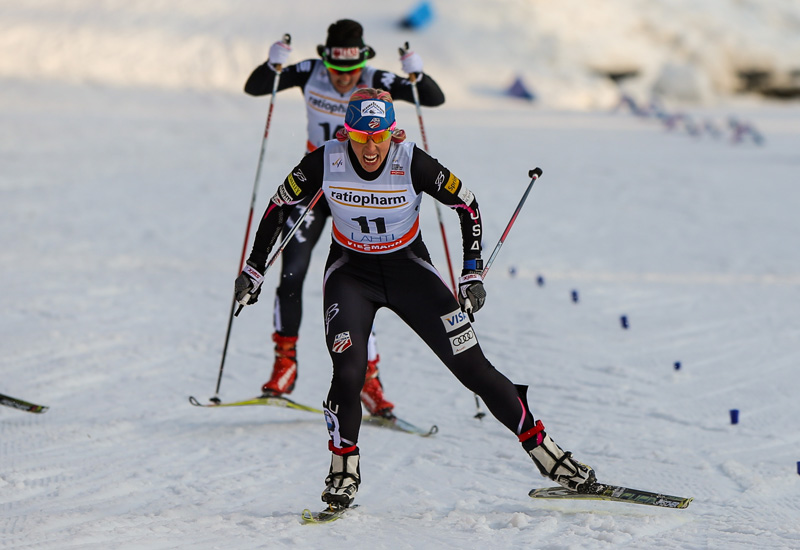
The frustration in U.S. Ski Team Head Coach Chris Grover’s voice was clear after Sunday’s 1.3-kilometer sprint in Davos, Switzerland – on one hand his skiers had demonstrated their strength with strong qualification and aggressive skiing in the heats, while on the other, their potential results were impeded by uncharacteristic falls.
Kikkan Randall led the team with her first top-10 finish of the season in ninth with Sophie Caldwell trailing in 11th. Jessie Diggins and Ida Sargent finished 22nd and 29th, while Simi Hamilton ended his day in 23rd.
“It was a good and bad day for us,” Grover said in a phone interview. “Bad in the sense that I can’t believe we had so many falls. We have some of the most talented cross country skiers in the world and they’re so good on their skis and somehow everybody was stumbling today.”
Even with the tumbles, the day proved to be a step in the right direction for the USST as they build their results through the season. In year where the team has aimed to start the season slow and faced illness and injury, Sunday’s results demonstrate the potential for continued progression.
“It was good in the sense that people who have been struggling to come back from injury or from illness or fatigue were moving a lot better,” Grover said referring to Randall and Hamilton who have recently battled sickness, and Caldwell who is recovering from a broken elbow she sustained in October.
The USST’s top finisher in ninth, Randall, started her day feeling better than she had all season. Earlier in the week she struggled in a intensity workout on the sprint course, but come sprint day Randall was ready to go.
“I had some better feelings this week compared to last week. Race prep yesterday felt a little better so I was optimistic to take another step forward today,” she said in a phone interview.
“I was really happy with the way I felt in qualifications and I could tell I definitely made a big step forward,” she added, referring to her 9th position in qualification.
Randall and teammate Sargent, who earned a fifth in November’s Ruka sprint, were placed in the same quarterfinal heat. Joined by Swiss sprinter Laurien van der Graaff, Heidi Weng of Norway, and Claudia Nystad of Germany, the Americans took off with Randall sitting in second up the first hill.
Randall soon found herself near the back of the pack after failing to give a full effort over one of the course’s many hills. It was there that Sargent made a tactical move and advanced into second position.
As the pack entered the stadium for the second lap of the quarterfinal, Randall saw an opportunity to move forward, but in the process she tangled with her teammate.
“I had a good line on the inside coming through the lap and I saw and opening to get to the outside,” Randall explained. “I felt like I barely grazed someone, I didn’t realize it was Ida but I knew I needed to have a good lane up the uphill. It ended up working out well.”
Once in a strong position, Randall and van der Graaff maintained a lead over the other women and cruised across the line to advance to the semifinals.
Sargent did not fare as well. After the small tangle with Randall she fell back to fourth. As the group climbed the next hill, she and Weng crossed skis resulting in a faceplant for Sargent and an eventual sixth place finish in the heat.
“I came in last in my heat but I guess that’s sprint racing,” Sargent wrote after the race. “[It] gives me motivation for the next one.”
Meanwhile, the next quarterfinal featured Caldwell, Norwegian Ingvild Flugstad Østberg, and 2010 Olympic Champion Charlotte Kalla of Sweden.
Caldwell watched Østberg charge to a convincing victory the previous week in the same event, and decided that her best chance at advancing was sticking with the Norwegian.
That’s exactly what she did, and from the start of the gun the two skiers were well ahead of the four other women in the heat. But going all-out from the start took its toll on Caldwell as she started to fade just as Kalla began to pick up speed.
“I told Gus [Kaeding] that my strategy was to stick with Ingvild until I blew up, and that’s exactly what I did. I blew up on the second hill,” she said in a phone interview.
Despite losing ground, Caldwell held onto third place behind Østberg and Kalla. The heat was fast enough to earn her a lucky loser spot in the semifinals with Randall.
The only Americans to land in the semifinals, Randall and Caldwell had their eyes on a visit to the final – but events didn’t unfold the way the two had planned.
As the racers moved up the first hill Caldwell fell, taking the 24-year-old out of contention.
“I honestly have no idea [what happened],” she said. “I don’t think it was related to anyone else. I don’t know if I pulled between my legs or hit an icy patch, but I was in a pretty good position going up the hill, and the next thing I knew I was just on my knees and the pack skied away.”
With Caldwell out of the picture Randall sat near the back of the pack of five women, waiting to make her move. The opportunity came on an icy corner where she attempted to take a wide turn and use the momentum to accelerate past her competitors.
Instead she found herself on the ground.
“I was set up and I started to look up to decide where I wanted to make a move. Right then I hit ice and my feet went out from under me. I went from ‘ok, I’m in a good position’ to ‘oh, now I’m down,’” she said.
After the fall, it was clear that Randall had lost her momentum and any chance of advancing. She and Caldwell eventually skied together, and took fifth and sixth positions.
Randall was disappointed the fall prevented her from achieving her full potential, but was pleased to feel like her old self again.
“It was a bummer to fall because the feelings were a lot stronger today. I could have been in the fight to move into the final, and in the final anything can happen. I was just really happy that I felt more like myself today. You don’t realize how bad you were feeling until you start to feel good again. I’m happy the trajectory is going uphill,” she said.
“It was a weird start to the season so I’m glad to be feeling like I am coming back,” she added.
Caldwell demonstrated that she’s made a near-full recovery in terms of fitness and racing.
“I was trying not to think about results at all [earlier this season], but it’s never fun to be that far back, and I was just thinking ‘oh God, am I ever going to get back there this year, and how long is it going to take,’” she said of the first weekends of World Cup racing. “I’ve just taken big steps the last two weekends, and that helps a ton with my confidence.”
Diggins was the other U.S. woman to qualify for the heats in 17th. Diggins prefers to race longer courses that provide opportunities to pass, which made Sunday’s race a challenge for the Minnesota native. Given all the factors, she said was pleased with her qualification.
“I went into it with a plan for every inch of the course, and I was able to execute the plan and finally qualify. So that felt really good to be able to go into it saying, ‘okay, here’s what I need to work on, here’s what I’ve practiced for,’ and then have it turn out,” she said of her qualification.
Diggins was the only U.S. skier in the finals who did not fall, but on a final hill in her quarterfinal she and Maja Dahlqvist of Sweden collided which slowed her progress and eventually led to her fifth place finish in the heat.
In the men’s race, Hamilton was the lone U.S. male to qualify for Sunday’s heats. While the illness that kept him from racing in the previous weekend’s sprint had run its course by Sunday, Hamilton said he still wasn’t feeling 100 percent.
Qualifying 14th, Hamilton skied the beginning of his quarterfinal with confidence and strong tactics. Near the front of the pack, Hamilton was waiting for a moment of weakness from the heat’s leader, Emil Jönssen of Sweden. The opportunity came as Jönssen faded the course’s final hill.
That’s when he became a victim to yet another USST fall.
“I think it was that and a combination of hooking my right tip in a little bit of the softer snow that was on top of the ice. It just caught me and I rocked forward. Before I even knew it I was down on all fours,” he said.
While Hamilton was eventually able to recover to fifth position in his heat, the placement was far from advancing to the semifinals.
“I think that in 90% of sprint days, little things happen that throw you off your game. What makes really good ski racers is being able to move past those little things,” he said, explaining that the “little things” for him on Sunday were his health and his fall.
While Hamilton believes he was far off his mark, the result gives him confidence as he heads into the short break before the Tour de Ski.
“You keep plugging away, if you’re patient and confident, sooner or later it’s going to pay off,” he said.
Grover said that there was no particular reason for his team’s abundance of falls, and chalked it up to bad luck.
“These are typically athletes who don’t fall – Kikkan was trying to remember the last time she had a fall in a sprint. I think it just happened to be some bad luck for a number of people out there,” he said.
Grover said the team was sitting in a good position as they take a short break before partaking in the Tour de Ski in January.
“I think we’re feeling really optimistic about the team’s shape at the Tour de Ski. Right now everything is pointing to catching up with the competition. It’s been a slow start but we’re starting to pick up some momentum,” he said.
Caldwell summed up the team’s sentiment, explaining the day’s results show the she and her teammates are on the right track.
“It definitely leaves us wanting more, it’s a bummer we all fell, but I think it’s a boost of confidence – that’s how we felt today, knowing our potential,” she said.
The majority of the of the USST will remain in Davos for Christmas, as the rest of central Europe is facing a lack of snow. Sadie and Erik Bjornsen will head to France for the Holidays.
Racing returns January 3, with the Tour de Ski 3/4 k prologue in Oberstdorf, Germany.
Lander Karath
Lander Karath is FasterSkier's Associate Editor from Bozeman, Montana and a Bridger Ski Foundation alumnus. Between his studies at Middlebury College in Vermont, he is an outdoor enthusiast and a political junkie.


